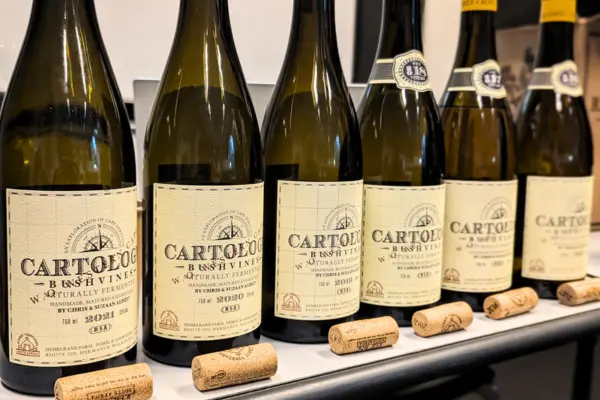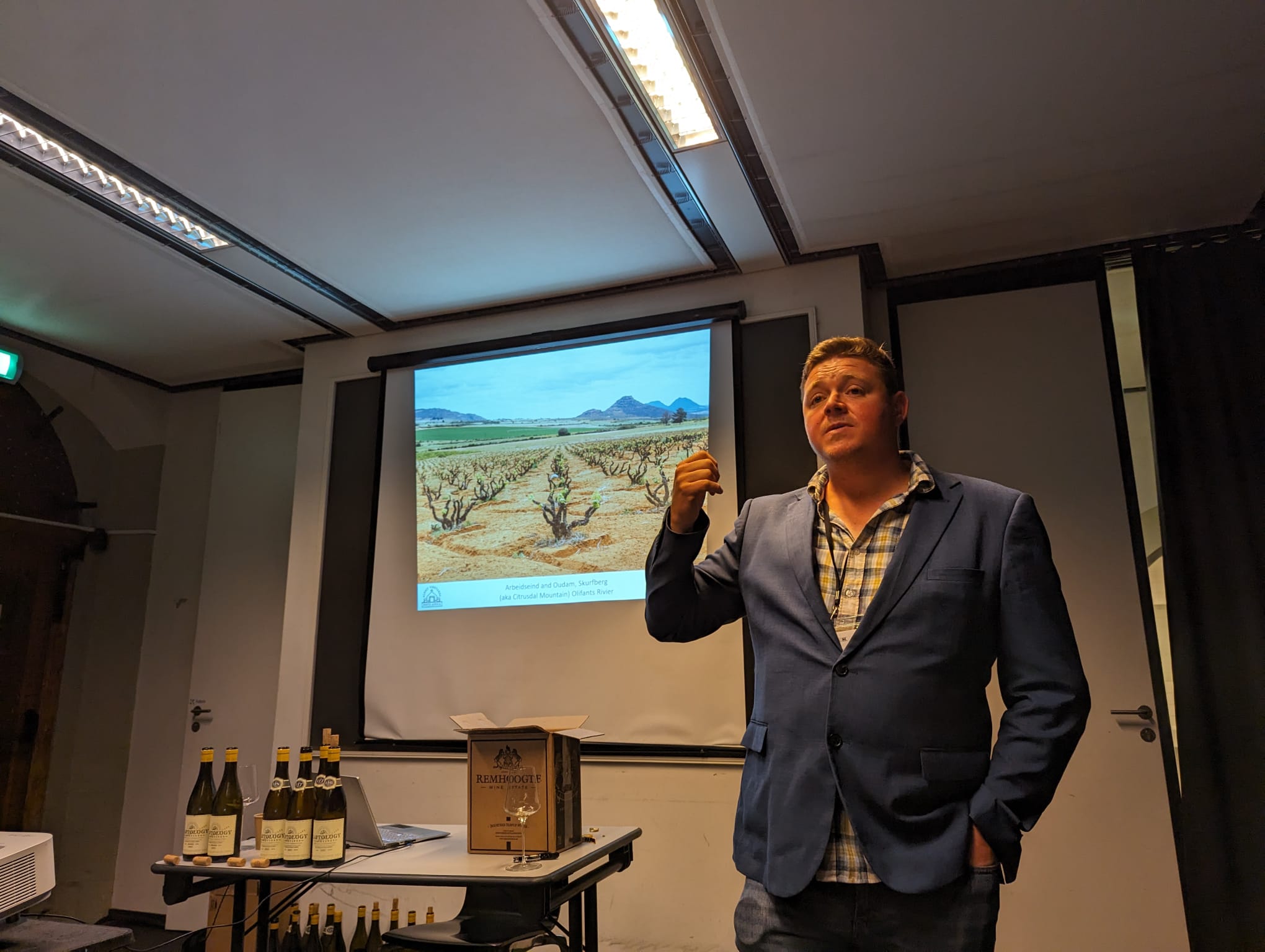June 12, 2024
Alheit Cartology Vertical Tasting with Chris Alheit

After a long period where South African wine was known for low-cost supermarket wines, the country has been going through one of the most significant and unique revivals. The Swartland wine region has become a hotbed for talented winemakers dedicated to producing soulful, low-intervention, terroir-specific wines that embody a distinct South African identity. Leading this movement is Chris Alheit, a passionate and humble winemaker. His aim is to craft wines with precision—powerful yet with balance. He describes his vision to "make the most South African wine ever," with Cartology being "about as Cape as a Cape wine can get."
An afternoon with Chris reveals his unwavering dedication and perfectionism. He passionately showcases the diverse terroirs of the Cape through his wines. It wasn’t all smooth sailing for Chris and his wife Suzaan however, as their story is incredibly unique and comes with twists and turns. Leading wine critic Tim Atkin MW frequently ranks Alheit’s wines among the best South African whites each year. Recently, we had the privilege of meeting Chris and tasting a vertical selection of Cartology from 2016 to 2021, gaining a deeper understanding of the wines and their ageing potential. We’re in no doubt that Alheit produces some of the best white wines in South Africa. Let us tell you his story and about the wines.

Photo: Chris in action during our tasting explaining the different vintages
The Beginning of Alheit's Journey
Chris Alheit’s journey into winemaking began unexpectedly. Initially a medical student, he struggled academically and found a new path after befriending winemaking students. This pivotal change led him to meet his wife, Suzanne, also a winemaking student, and together they travelled around Western Australia and California. They lived on a farm just outside Stellenbosch, but after two vintages, they felt there might be more to life.
Tasting Eben Sadie’s wines profoundly impacted Chris and Suzaan Alheit, opening their eyes to new possibilities. This inspiration led them to Europe, where Alheit worked in Bordeaux (Chateau Angelus), immersing himself in French wine and tasting old vintages. Experiences in Clare Valley and further European travels, including visits to Santorini, Domaine Gauby, Domaine Matassa, and the Mosel, solidified their vision of authenticity. One of the most valuable lessons Chris learned was in Greece, where he drove around on a moped with his wife, asking local winemakers how they managed to produce such fresh wines in a hot climate.
The Search for Vineyards
Upon returning home Chris and Suzaan decided to start their own project to make the most South African wine ever. The search began with a clear vision: to source the best old-vine Chenin Blanc and Sémillon in South Africa. Chris reminisced how they used google maps and google satellites to look for old looking vines and vineyards in the Cape. Then they would simply drive to those places, check them out and offer to buy them. Having very little luck with their approach did however lead to the pivotal connections with notable figures in the wine industry, such as Rosa Kruger, a renowned old-vine viticulturist.
In the early days, Alheit and his wife, Suzaan, lived modestly, putting all their resources into their winemaking working two jobs. Their determination paid off when Rosa Kruger informed them about the availability of old-vine Chenin Blanc in the Skurfberg region. This vineyard, known for its high-altitude, rocky terrain, was previously used by Eben Sadie and the Ruperts of Anthonij Rupert Wines. Recognizing the potential of these vines, Alheit seized the opportunity, marking the beginning of Cartology’s journey.
Alheit's exploration didn’t stop there. He scoured Stellenbosch and other regions, hunting down neglected old-vine vineyards that could contribute to his vision of authentic South African wine. Each vineyard was chosen for its unique terroir, which Alheit believed would express the true character of the Cape in his wines.

Photo: Chris in the fire by night vineyard
Winemaking at Alheit:
Chris prefers large foudres, concrete and old barrels as he wants the vineyards or terroir to show through on the wines. Alheit emphasized minimal intervention, believing that true terroir cannot be achieved through manipulation. His wines are farmed organically with minimal sulfur dioxide used before bottling. He employs whole-cluster pressing, racks and returns the solids, and allows natural microflora to drive fermentation. He remained committed to producing a heritage wine, including Semillon for its depth and historical significance. His winemaking philosophy eschewed early or late picking, focusing instead on the natural expression of the grapes.
A perfect debut:
The 2011 vintage marked the debut of Alheit’s first Cartology wine, which received rave reviews. Neal Martin, then with the influential Wine Advocate, praised it highly, stating, "So, you want a headline or a snappy, eye-catching shelf-talker? Here’s one: 'Chris and Suzaan Alheit have made South Africa’s greatest debut Chenin Blanc'." With a score of 96 points and an affordable price tag (which the wines still carry), Cartology was a real hit and exploded in popularity amongst wine collectors and they’ve never looked back!
Vertical tasting of Cartology:
Chris highlighted the different vintages in our tasting and one recurring theme was if it was a dry year or not. Chris pointed out that a slight tannin on the finish as being one of the signs of a dry year when tasting the wines.
As a rule of thumb, 5 years after release is when the wine starts to transform with the 2017 being the most expressive and developed for our tasting. The 2019 was a personal favourite for its nervy tension that kept me coming back for more.
Cartology 2021
2021 was a dry year, resulting in a wine with a delicate, perfumed nose and huge complexity with undertones of minerality. The palate was texturally beautiful, refined and balanced showing a nice balance between fruit and beeswax. A nice long finish.
Cartology 2020
“Just enough water to make an outstanding wine” recalled Chris. He was even happier when Eben Sadie called him to say that the Cartology 2020 was the best wine Alheit had ever made. Fresher, more saline on the nose with cooler fruit and hints of floral notes on the nose were complemented by a waxy, leesy texture on the palate.
Cartology 2019
Chris described ’19 as a “good year with good quality and volume for once”. 2019 was one of my favourite vintages from the lineup as it carried this great tension and a long finish. It was also had most pronounced smoky minerality on the nose which I am a fan of.
Cartology 2018
2018 marked the introduction of Diam 30 closures, enhancing the wine's ageing potential. The vintage displayed a salty, nutty vibe with expressive tertiary characteristics. Leesy waxiness added richness to the palate, complemented by a pronounced mineral finish which were due to it having aged in the cellar longer than the previous vintages.
Cartology 2017
Chris was fussing over which bottle of 2017 was served as one bottle was supposedly showing better than the rest. Wow, the wine was singing and it even impressed Chris how good the bottle was. Floral notes, honey combe, nutty on the nose yet pure and precise on the pallet. It showcased how well Cartology can age in the cellar. We’d advise drinking the 2017s now or within a couple of years.
Cartology 2016
The 2016 year was marked by dry conditions and despite this the wine had an incredible amount of finesse and class. The 2016 still seemed to be a baby showing how well and long Cartology can age for. On the nose, it offered delicate floral aromas with a hint of ripe citrus. On the palate secondary flavours of wax and a touch of salinity added depth to the finish.
Cartology 2012 & 2015
Although not tasted during this session, Chris recommends drinking the 2015 now and holding onto the 2012 a bit longer.
